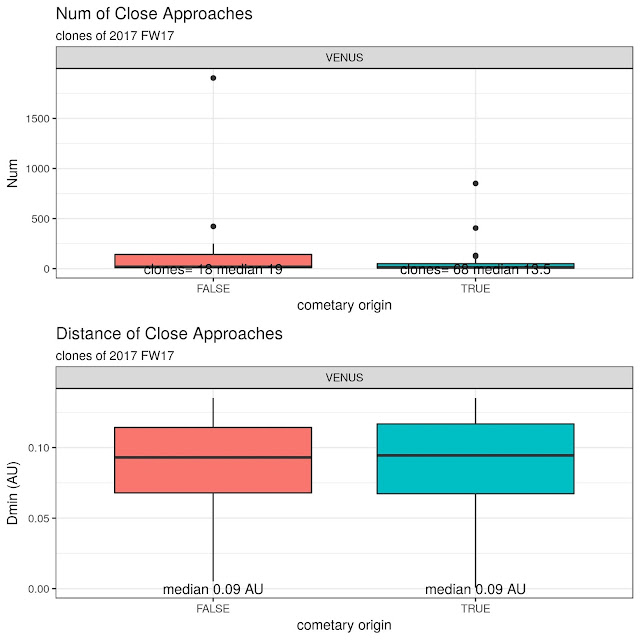A possibility that should be investigated is that these asteroids separated recently from a common body ... see previous posts for a draft analysis.
Another aspect is that they might have a cometary origin.
For what's worth, considering the uncertainty (orbit condition code 4) and considering that I do not take into account non gravitational effects, I made a backward simulation with 2019 PR2
2019 PR2
| Orbital Elements at Epoch 2458600.5 (2019-Apr-27.0) TDB Reference: JPL 47 (heliocentric ecliptic J2000)
| Orbit Determination Parameters
Additional Information
|
Clones
I generated 100 clones trying to achieve the same orbital parameters as calculated by JPL Small Body Database
| Clones | Target | ||||
|---|---|---|---|---|---|
| mean | sd | mean | sd | ||
| q | 1.16789207 | 2.25e-06 | 1.16789224 | 2.25e-06 | |
| e | 0.79767637 | 1.375e-05 | 0.79767731 | 1.376e-05 | |
| i | 10.98949691 | 9.732e-05 | 10.98950352 | 9.717e-05 | |
| peri | 57.08261449 | 0.00010684 | 57.08261419 | 0.00010673 | |
| node | 349.03812785 | 0.00014309 | 349.03813204 | 0.00014302 | |
| tp | 2458781.99180559 | 9.518e-05 | 2458781.99180039 | 9.519e-05 | |
Simulation
Mercury6 simulator was set up like this (param.in file):
)---------------------------------------------------------------------
) Important integration parameters:
)---------------------------------------------------------------------
algorithm (MVS, BS, BS2, RADAU, HYBRID etc) = BS
start time (days)= 2458849.5
stop time (days) = -1d8
output interval (days) = 100
timestep (days) = 0.05
accuracy parameter=1.d-12
...
ejection distance (AU)= 1d2
As shown above, the arbitrary threshold to declare that a clone has a cometary origin is set to 100 AU
I take into account all planets plus asteroids Ceres, Pallas and Vesta.
Simulation results
At the end of the simulation, we find:
- 72 out of 100 clones were ejected from the solar system
- 2 out of 100 clones "hit" the sun
Considering that the simulation is backward in time, the above results must be read as:
- 72 out of 100 clones have a cometary origin (they entered the solar system from a distance greater that 100 AU)
- 2 out of 100 clones seem to have originated from the sun ! (we have to discard these as impossible results)
The following plots have been done using R scripts and package ggplot2.
First of all, we can see that there is not a "single" point in time when the clones likely to have a cometary origin have entered the solar system even though the are slightly more concentrated around 29000 years ago
Distribution of min perihelium
The simulation time has been divided into 10 slots.
In every slot, for every asteroid, we calculate the minimum perihelium that it had during that period.
The various values are shown in a boxplot.
A similar approach is used for all the other plots.
Distribution of max aphelium
Some clones entered the solar system on a hyperbolic trajectory, it does not make sense to calculate an aphelium (infinite) so they are not shown here:
... ooops!, an outlier ... if we omit it we have a better idea ... actually, we have to omit them about a dozen times before seeing something:
...again after omitting several outliers:
Distribution of max Orbital Energy
In this graph, those clones with orbital energy >0 are on a hyperbolic orbit:
Distribution of Vinfinity
For those asteroids having an hyperbolic trajectory, it make sense to plot their Vinfinity:
Distribution of max eccentricity
References
Mercury6 simulator:
J.E.Chambers (1999) ``A Hybrid
Symplectic Integrator that Permits Close Encounters between
Massive Bodies''. Monthly Notices of the Royal Astronomical
Society, vol 304, pp793-799.
package R:
R Core Team (2019). R: A language and environment for statistical
computing. R Foundation for Statistical Computing, Vienna, Austria.
URL https://www.R-project.org/.
package ggplot2:
H. Wickham. ggplot2: Elegant Graphics for Data Analysis.
Springer-Verlag New York, 2016.
Cheers,
Alessandro Odasso























